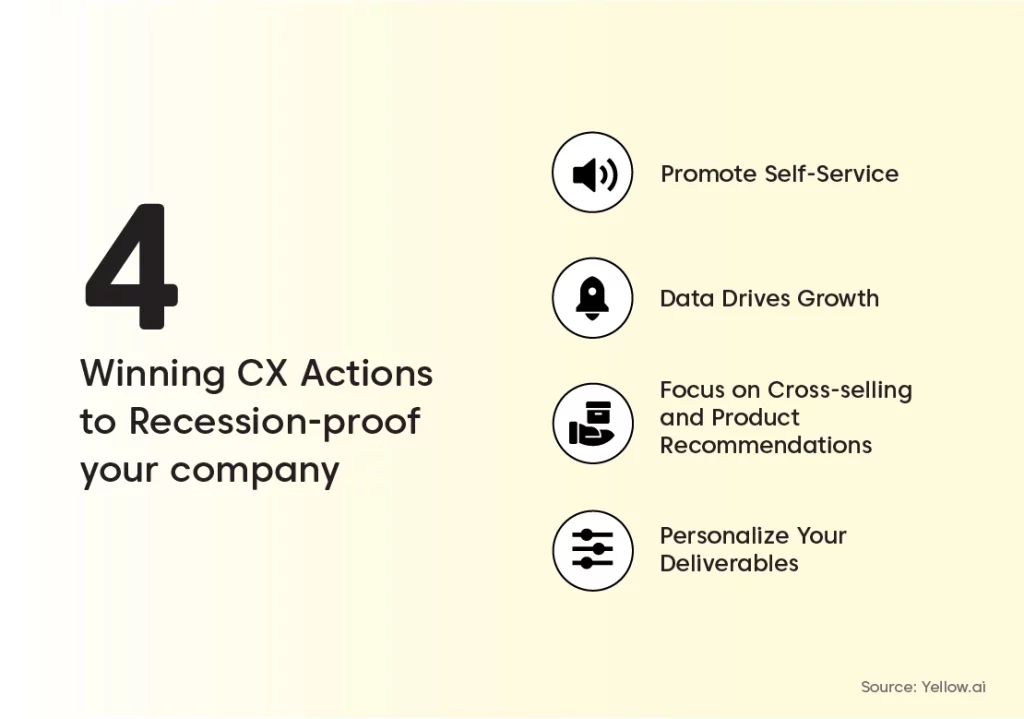An economic downturn is bound to affect companies in different ways, including their customer experience strategies. Thus, the main challenge for business leaders is not just to sustain in the market, but also to ensure that existing customers are not affected by their organizational restructuring.
In an uncertain economic landscape, businesses are hard-pressed to ensure that their finances and operations remain afloat. While cutting costs is a logical first step for many organizations, it can lead to reduced efficiency or customer dissatisfaction. It’s easy to overlook the value of customer experience (CX), but in fact, this should be a priority even during times of economic hardship.
Here’s why CX leaders and organizations need to maintain focus on CX activities when facing economic turbulence:

1. Switch to automation and self-service options to fill the agent gaps
Your business’ customer service doesn’t entail only customer calls. Thus, deciding which activities would give you a competitive edge over other businesses as you face the recession head-on is important.
A report on self-service portal usage by Statista confirmed that 88% of buyers expect companies to offer an online self-service portal.
When you invest in UI tools that help you build self-service tools, you make it easier for your customers to access your company’s services independently, thus resulting in fewer calls and emails.
By automating processes and setting up self-service tools, you get to:
- Permanently lower operating costs.
- Enhance and boost output, and free up expensive, in-demand talent to concentrate on value-adding tasks.
- Increase the production of digital services that are more beneficial to customers and your employees.
2. Understand your customers’ needs using data
Understanding your customers’ expectations is key to delivering world-class CX. Every customer interaction offers data that can be analyzed to wow them at every turn. By employing customer analytics, you can keep the pulse on your customers to drive loyalty and growth.
For example, the rise of fast-casual dining was driven by the Great Recession in 2007 as consumers wanted to explore away-from-home eating options but without a restaurant’s premium charges. Leveraging analytics can reveal opportunities to launch new products that resonate well with your customer’s ever-changing needs, revise pricing, or customize services, giving your business a sales boost.
3. Focus on Cross-Selling and Product Recommendations
Acquiring a new customer is 5–25 times more expensive than keeping a current one, thus, working on product recommendations and cross-selling is a far more profitable way to grow your business during a recession.
Did you know?
35% of Amazon’s sales revenue comes from product recommendations to browsing customers.
Cross-selling your products and services would raise the average order value for your company and enhance sales from current customers. Encourage your support and sales agents to interact with your consumers more. Customers can then receive frequent product recommendations from these agents during ongoing talks.
4. Offer personalized services to your customers
If companies have their share of apprehensions during economic turmoil, it’s only fair to expect the same from your customers before they make any purchase.
Customers want to spend every penny mindfully during a recession. One of the best ways to make them feel valued and get them to build trust with your brand is by offering personalized services.
91% of consumers claim they are more likely to buy from companies that make offers and suggestions that are pertinent to them when they are shopping.
Here are a few ways to personalize your customer service:
- Provide your customer service agents access to historical customer data. This will help them to understand past brand engagements.
- Prepare special offers relevant to each consumer by keeping track of customer information.
- Address consumers by name to offer an excellent first impression since it makes them feel appreciated.
- Ensure your personalization is available across all channels, including chat, email, social media, and mobile apps.
Prepare for survival and plan for acceleration with Yellow.ai
When the economy is down, it’s important to invest in automation, self-service, analytics, and personalization—the focus on overall CX will help you stand out from the competition. Ensure that your customer insight and feedback programs are functioning end to end. Doing this will make you aware of how your customers feel and how you could support them.
Using Yellow.ai’s analytics dashboard you can get a detailed understanding of your customer’s sentiments with the proprietary NLU engine. You also get to track their positive or negative sentimental trends to get deeper insights, not just impressions and clicks. Additionally, the campaign management tool helps you to identify the intent behind your visitors’ journey on-site and direct them to solutions they are interested in with timely suggestions for faster conversions.
Yellow.ai’s capabilities can help turn the large volume of customer and product journey data across different channels into a 360-degree view that drives action to improve experiences.
















